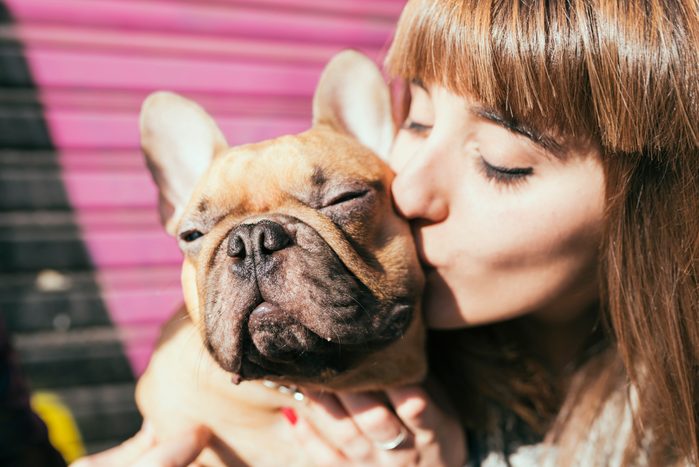
The most popular dog breeds you’ll fall in love with
Each year, the American Kennel Club (AKC) releases a list of the most popular breeds from a huge number of dog breeds recognized by the organization. For dog lovers, this is the equivalent of watching the Oscars! But how do the powers-that-be arrive at these results when they have 200 pawsome breeds to choose from? Are dog breeders sending goody baskets to woo the judges? Nah, it’s nothing that nefarious. The ranking is purely based on AKC registration statistics and not subjective categories like the most loyal dog breeds, the best snugglers or dogs that are the easiest to train—although you’ll see dogs from those categories on the list, since those characteristics are a big reason the breeds are so popular.
Wondering which dogs made the list? We have all the details on the top 10 dog breeds in the United States, starting with No. 1. Reader’s Digest also asked two veterinarians—Jaclyn Coble, DVM, founder of Sea Legs Integrative Veterinary Health in West Roxbury, Massachusetts, and Erin Tate, DVM, who works at CityVet in Dallas—to give us the lowdown on each breed. Whether you’re thinking of adopting or you’re just curious, you’ll find out everything you need to know below.
Get Reader’s Digest’s Read Up newsletter for more pets, cleaning, humor, travel, tech and fun facts all week long.
About the experts
Reviewed for accuracy by: Caroline Coile, PhD, an award-winning journalist specializing in canine breeds, health and science. She’s the author of 34 books, including Barron’s Encyclopedia of Dog Breeds. |
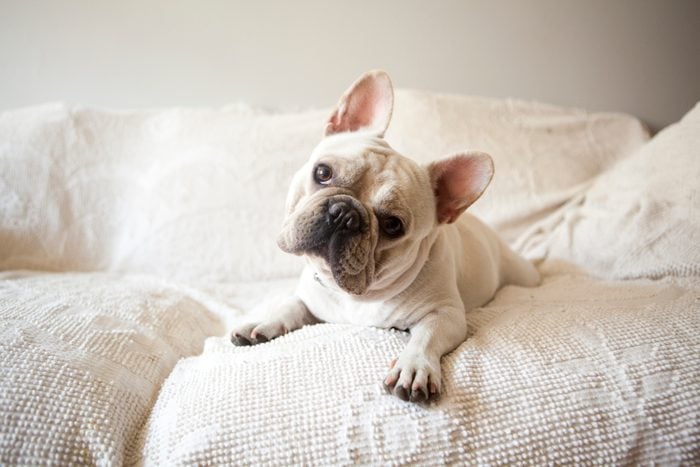
1. French bulldog
The French bulldog is holding on strong to the No. 1 title of the most popular dog breed in the U.S. after dethroning the Labrador retriever’s 31-year reign in 2022. To be fair, Frenchies’ adorable wrinkled faces, bat-like ears and short legs are irresistible. And Americans weren’t the first to notice: Frenchies, which were originally bred from toy bulldogs in England, were super popular in Nottingham, the center of lace making. When the British lace factories shut down in the mid-1800s, many of the displaced workers moved to France and took their Frenchies with them. That’s when they became all the rage in Paris. “They were favored by the Parisian belles de nuit (ladies of the night) and artists, which gave the breed an air of bohemian allure,” says Dr. Tate.
Fittingly, Frenchies have their own “artsy” language. “French bulldogs are known for making a wide range of unusual sounds, including yips, gargles, yodels and various other vocalizations that are not typical barking,” says Dr. Tate. What can we say? They have a lot of personality! Frenchies are also beloved for their all-around good nature, as well as their love of people and fellow furry critters.
Also, explore the world of these magnificent large dog breeds renowned for their suitability as wonderful family companions.
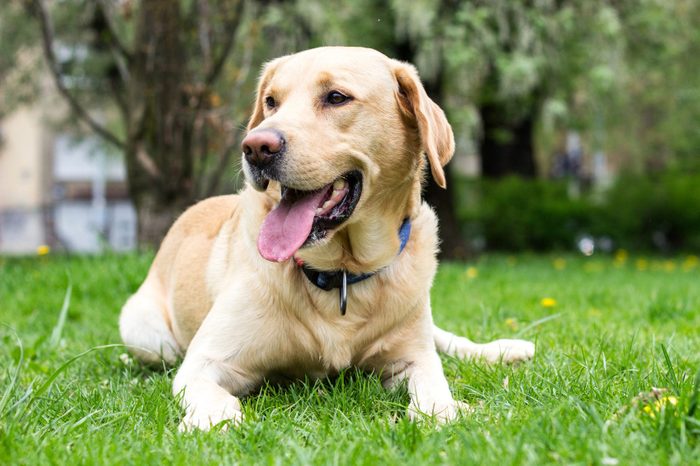
2. Labrador retriever
The Labrador retriever had a solid three-decade run as America’s favorite dog, but hey, taking the silver isn’t bad! You probably see Labs everywhere—in town, on the trail, at the beach and at the dog park—because they’re among the most common dog breeds to own and excellent dogs for first-time owners. They’re easygoing and happy, and they make new human and doggy friends easily.
Interesting fact: Labs have an “otter-like” tail because they were initially bred to help fishermen and hunters retrieve fish and game from the water. “Labrador retrievers’ powerful tails act like a rudder, helping them to steer and balance effectively while swimming,” says Dr. Tate. On land, that tail keeps going, and Labs are known for their exuberant tail-wagging. While this is admittedly adorable, it can be problematic if their tails repetitively strike door jams, furniture and other hard surfaces. “This trait can lead to ‘happy tail’ injuries, causing wounds to the tip of the tail,” explains Dr. Tate, so take note if your dog ever starts paying a little too much attention to its tail.
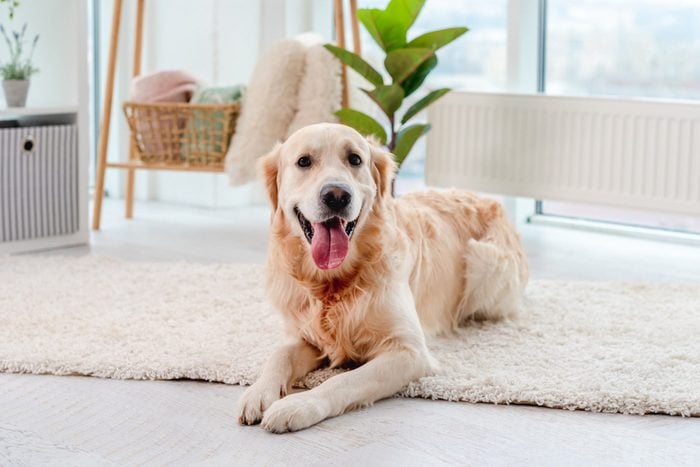
3. Golden retriever
“Hopelessly devoted to you” is what your Goldie’s social media profile might say if it had one. “Golden retrievers are great family dogs,” says Dr. Coble. They love humans of all ages and have reservoirs of empathy and compassion. While they’re blissfully content in a family with young, energetic children, they’re so adaptable that they also make the best dogs for seniors. It’s no wonder they’re so popular!
That said, they like to be active, and they’re open to just about anything—long walks or retrieving balls in the backyard. There’s just one favor golden retrievers ask in return: a little help with their fur. “Make sure you invest in some good brushes to keep that coat beautiful,” says Dr. Coble.
Also, don’t miss out on these 15 adorable Wire-Haired Dog Breeds—ready to be your family’s new best friends!
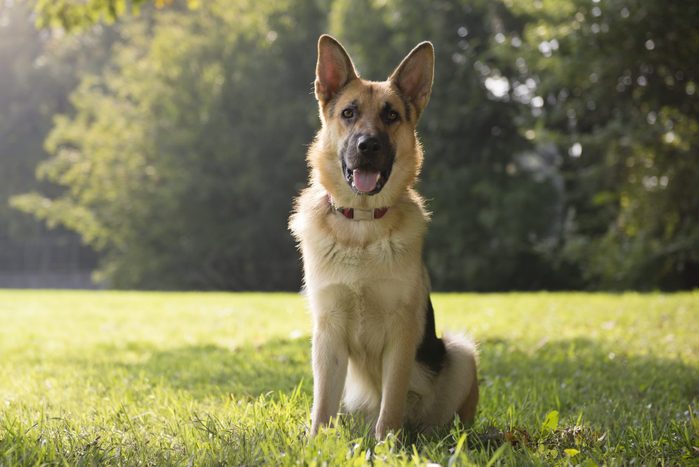
4. German shepherd
German shepherds are smart, athletic and easy to train, which is why they are highly valued K-9 members of the police force, detecting drugs and bombs with their sniffing skills. “Their intelligence allows them to be trained for complex tasks such as sniffing out explosives and narcotics, tracking criminals, finding lost people and even alerting a deaf person to sounds,” says Dr. Tate.
Aside from being stellar service dogs, why are they one of the most popular dog breeds for regular folks? Devotion and loyalty. German shepherds show 100% unconditional love to their human families and pet siblings, and they are also incredibly protective over them.
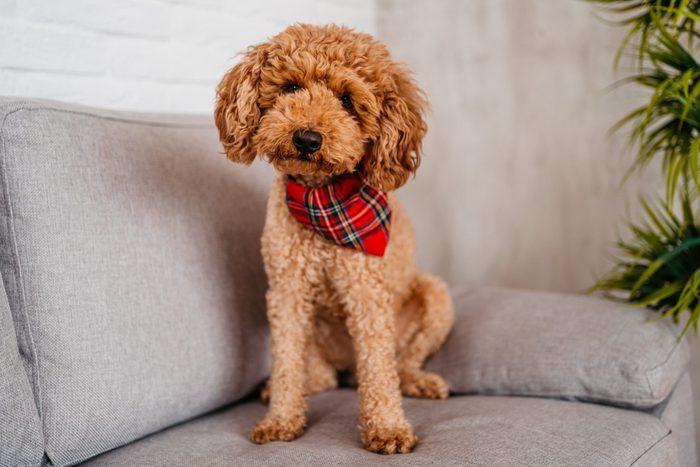
5. Poodle
One reason people love poodles? Their cute, curly locks of hair. Yep, hair. Poodles have hair, not fur, which may help lower the chance of allergic reactions for some people. We’re not going to sugar-coat it for you, though: Those curlicues don’t stay like that without maintenance. Poodles require brushing and combing every other day and a clipping every six weeks to prevent painful matting.
But it’s worth it because they are one of the sharpest breeds on the block—known to be highly trainable, quickly picking up obedience skills and new tricks. Combine that with their playful, loving and good-natured personalities, and you have the formula for the ultimate companion that comes in three perfect-for-you sizes: standard, miniature and toy. If you’ve always dreamed of having a dog that looks like a teddy bear, you might want to choose the miniature or toy size, so you can easily scoop them up and carry them around. But you should give the bigger variety serious consideration too.
“The purebred poodle has become overshadowed in recent years by designer breeds like the Labradoodle and Bernadoodle,” Dr. Coble says. “[But] poodles deserve more attention, as they are intelligent, sweet and make excellent family dogs.”
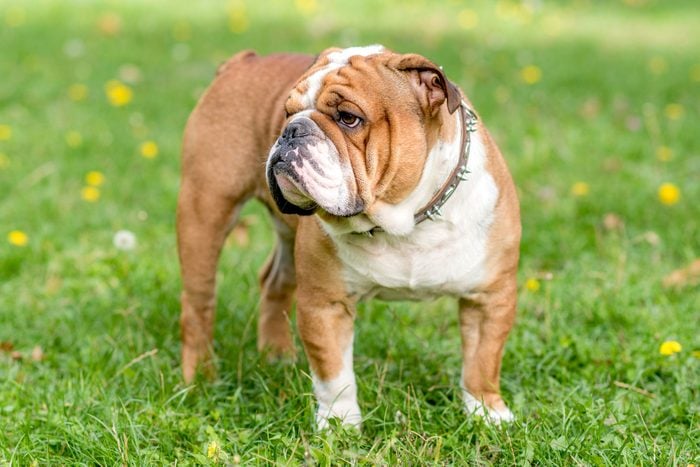
6. Bulldog
There are plenty of bulldog breeds, but for this list of the most popular dog breeds, we’re specifically talking about the English bulldog that originated in England way back in the 13th century. Like many other flat-faced breeds, they have adorable wrinkles, curmudgeon faces and stout bodies. Temperament-wise, these cuties have a chill vibe going for them, with a gentle and composed personality—but still have a streak of bravery. They are people-oriented and seek regular attention, but they’re too dignified to bark to get it.
You are pretty much guaranteed, however, to hear their charming snores when they sleep. “Be prepared to listen to them snoring all day, every day,” says Dr. Coble. Just be aware that as with other flat-faced breeds, bulldogs are prone to brachycephalic airway syndrome (BAS). Along with the snoring, it can cause breathing difficulties and even increase the risk of heatstroke.
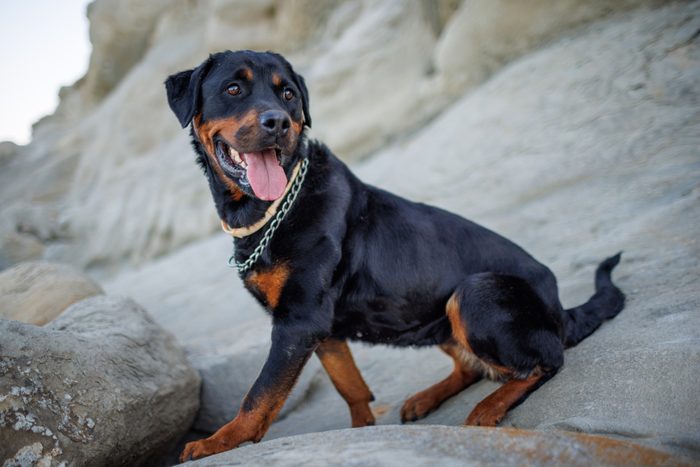
7. Rottweiler
At first glance, these guard dogs hardly give off a warm and fuzzy vibe, but that’s not their full story. “Rottweilers are known for being a bit aloof,” says Dr. Coble. “They love their owners, but they may not pay others much attention unless they are in protective mode.” They regard their human family as their “pack” and will bark loudly and growl as a way to guard and protect their home and family.
Rotties are genetically wired for protection, so it’s essential to socialize them and provide positive-reinforcement training to channel their natural defensive instincts in the right direction. Continuous socialization and slow introductions are critical to helping these dogs make new friends.
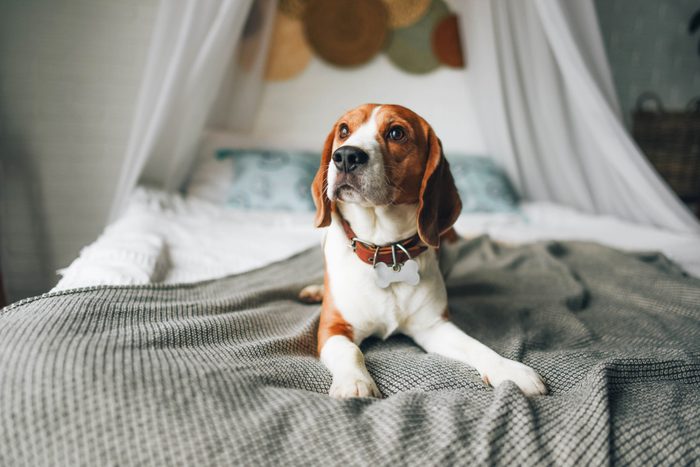
8. Beagle
Originally bred to hunt in packs, the beagle has always loved to be around other dogs. Today, they love to be around people just as much, which makes them ideal family pets. Beagles are playful and have a nose for fun and adventure—literally. “This extraordinary olfactory capability is due to the large number of scent receptors they have,” says Dr. Tate. “A beagle has approximately 220 million scent receptors, while humans have only about 5 million.”
Fair warning: Once they get a whiff of something interesting, all bets are off. They’ll probably ignore your calls to come back until they sniff out the source of the smell and are fully satisfied.
Be sure to check out these fabulous hairless dog breeds that redefine adorable!
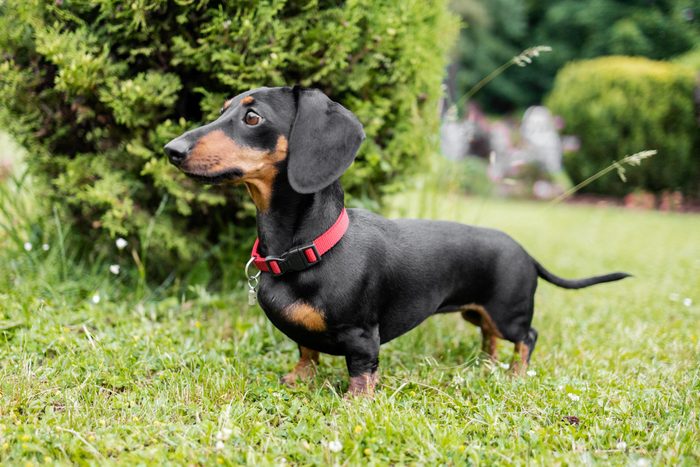
9. Dachshund
Besides being one of the most popular dog breeds, the peppy and headstrong dachshund was initially bred to bark and flush badgers out of burrows. Nope, those aggressive critters don’t back down to anyone—except the feisty dachshund! These dogs love to hunt and dig, and they bark while doing both of those things … and pretty much everything else. “Before you adopt one, make sure you are ready for the noise,” warns Dr. Coble.
That said, you really do get a lot of bark for your buck with these sweet dogs with long ears that feel like velvet. They come in two delightful sizes—miniature and standard—and in smooth, long or wire coats. Plus, they tend to be one-person kind of dogs and can live up to 16 years.
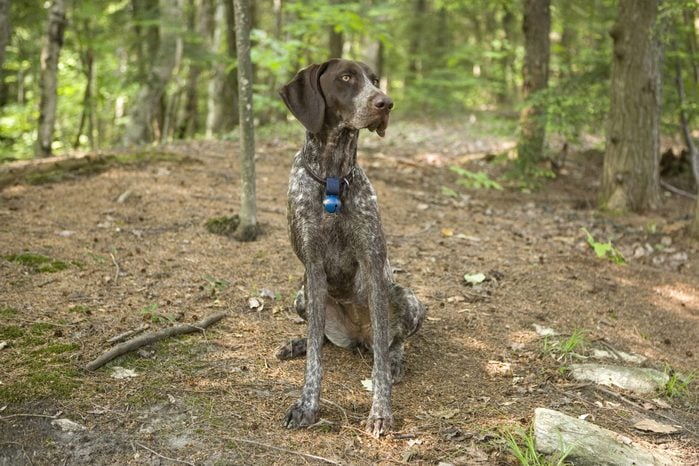
10. German shorthaired pointer
If you love the great outdoors and running on trails, the German shorthaired pointer (GSP) is the most faithful sidekick you could ever hope for. Their athletic prowess makes them one of the healthiest dog breeds, and their distinctive coloring and ticking (dubbed “fur freckles”) are striking to behold. But make sure that adorableness doesn’t lure you in if you’re not up for the challenge: These dogs require a substantial dose of daily exercise and wide-open spaces to run and play—on land or in the water. Exercising them 30 minutes in the morning and 30 minutes at night will help them stave off boredom and burn off pent-up energy. If you have a sizable fenced-in yard, even better.
Aquatic exercise is also an excellent idea. “This breed is known for its webbed feet—a physical characteristic not found in all dog breeds,” according to Dr. Tate. “This webbing allows the high-energy, intelligent breed to paddle efficiently through water.” That said, though the GSP is built for swimming, they may be hesitant to swim at first, and it may take some time and patience to get them comfortable in the water. But once they get their paws wet and start enjoying the water, you may have a hard time getting them out!
Why trust us
At Reader’s Digest, we’re committed to producing high-quality content by writers with expertise and experience in their field in consultation with relevant, qualified experts. For this piece on the most popular dog breeds, Lisa Marie Conklin tapped her experience as a reporter who has covered dogs for seven years, and then Caroline Coile, PhD, an award-winning journalist specializing in canine breeds, health and science, gave it a rigorous review to ensure that all information is accurate and offers the best possible advice to readers. We verify all facts and data, back them with credible sourcing and revisit them over time to ensure they remain accurate and up to date. Read more about our team, our contributors and our editorial policies.
Sources:
- Erin Tate, DVM, veterinarian at CityVet; email interview, Jan. 29, 2024
- Jaclyn Coble, DVM, CCR, CVA, veterinarian at Sea Legs Integrative Veterinary Health; email interview, Jan. 29, 2024
- Bulldog Club of America: “History of the Bulldog”
- German Shorthaired Pointer Club of America: “All About GSPs”
Next: Explore these white dog breeds and how to keep them clean.
